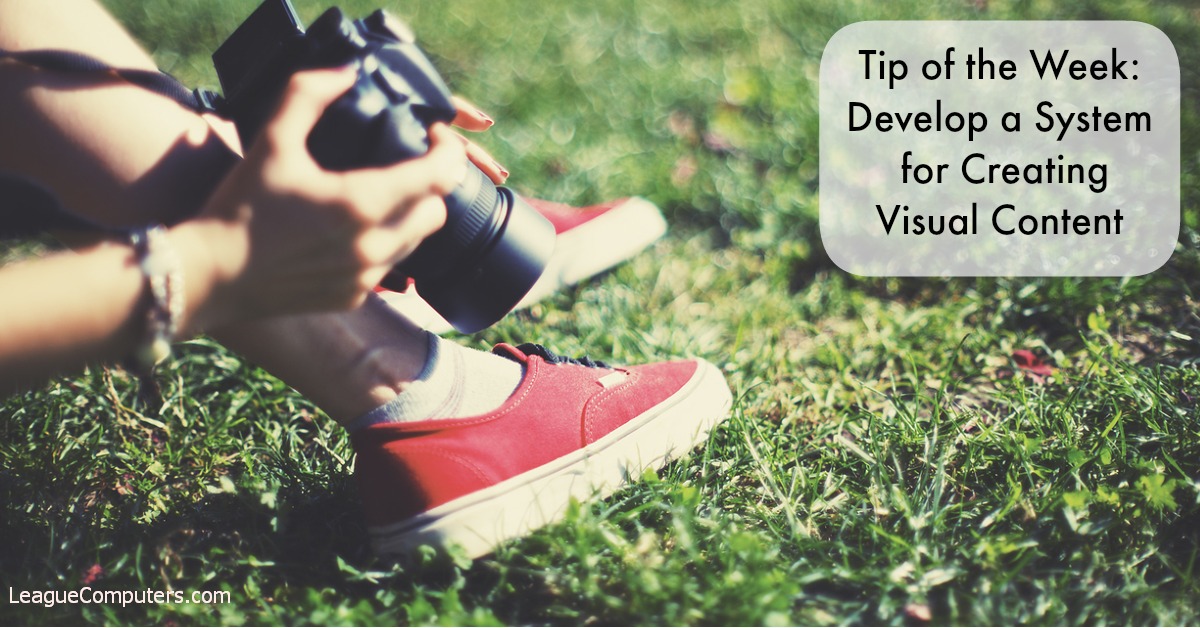Visual content should be part of your social media plan, but for many small business owners and solo-preneurs, the thought of spending another big chunk of your time taking photos or creating videos is overwhelming!
While professional photographers, graphic designers and video production teams are all important to a small business for major projects, website design and product launches, there are times when you just need to create a simple graphic for a blog post or a social media update. Having a plan and a system for creating day-to-day pieces of visual content can save a small business owner a lot of time and stress.
Here are four things you can do to develop a strategic visual content system:
1. Make the Best Use of Your Time
Your time is important, so be smart about taking photos – if you’re in a photogenic spot, take more than one photo with the plan to share them individually over the next few weeks or months.
Think of what photos grab your attention on social media; take a peak at what your competitors or industry influencers are posting that get a good response. Keep a list of your favorite visual content ideas.
Take a break from your routine: spend a day away from the office or use a lunch break to go take some photos specifically for your social media accounts. Whether they are shots of nature, your local area or a part of your office, look for interesting scenery or angles.
Create a series of shots/videos for use over a longer period of time. Do you have 6 tips you want to share with your target audience? Take the time to create 6 graphics all at once with similar colors and designs, and then share them later.
When creating videos, schedule a “video” day where you set up the equipment, scenery, and people necessary and focus on more than one piece of content. Create several videos that will be used over the next few weeks or months.
2. Use Free Image Sites
If you don’t have the time to take a photo for an upcoming post or you can’t find a specific item to photograph on your own, then check out some free photo resources.
Photos with a Creative Commons license on photopin.com, Flikr, MorgueFile.com, and FreeDigitalPhotos.net are a few options and sites that I visit on a regular basis for interesting photos. Just make sure you follow each site’s attribution / copyright requirements.
Don’t just go to these sites when you’re in need of one photo: set aside some time to find several interesting photos that fit topics you normally write about and build up a collection of photos you can grab when you’re short on time.
3. Find a Free Online Photo Editor That Works for You (and Stick with It)
My favorite photo editor is PicMonkey – you can do almost anything you want with the free version and it’s easy to get started.
Canva is another great tool, with a little bit longer learning curve than PicMonkey (in my opinion), but they offer some terrific video tutorials to help you out. Canva also has a large database of photos, either free to use or for the low price of $1.00 each.
For tools that help create Infographics and Charts, check out this list from CrazyEgg.
The important time-saving tip here is to stick with one editor if it’s working for you, and don’t get distracted by every new tool that comes along if you don’t have time in your schedule to learn how to use it.
4. Share your Visual Content Strategically
When you create visual content, keep your distribution strategy in mind.
Where will you be sharing your photos or videos?
You may want to keep some of your visual content exclusive to a certain site in order to drive more traffic; but there are other times when sharing to multiple accounts at once means more eyes on your visual content.
Share content from one social site to your other accounts:
- Instagram easily shares to Facebook, Twitter, and tumblr
- Pinterest Pins can be shared to Twitter just by checking a box
- Vine videos can be shared on Twitter and Facebook (as well as viewed on the desktop site)
- The Friends+Me tool allows you to share your Google+ posts to other sites (for free)
- Share your YouTube videos to G+ or Facebook
You get the idea…just like promoting a blog post on more than one channel is necessary, you should have a promotion schedule for your visual content.
How can you make it easy for your target audience to find your visual content?
There are features on each social site that you can use to group your visual content by topic or events, so your audience can easily view them. A few ideas:
- Hashtags on Instagram, Twitter, G+ – Create a unique hashtag that brands your visual content. Have you seen any of Lowe’s “fix in six” Vine videos? They use the hashtag #LowesFixInSix on each video and share them on a variety of social media sites like Pinterest and tumblr. You can do the same for your topical photos/videos or for an event, new product launch, etc.
- Photo albums on Facebook and G+ – Place your best visual content in special photo albums and then periodically share the album’s unique URL to drive traffic to it.
- Boards on Pinterest – Create a board for all your videos or SlideShares, a board just for image quotes or Infographics, etc. Then promote the board’s unique URL on your other social sites.
So there are four tips to help you develop an effective system for creating visual content. With a plan in place you won’t feel overwhelmed when it’s time to create visual content for your blog posts and social media updates.

